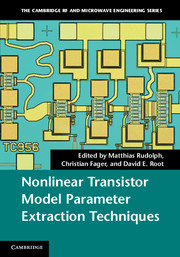Book contents
- Frontmatter
- Contents
- List of contributors
- Preface
- 1 Introduction
- 2 DC and thermal modeling: III–V FETs and HBTs
- 3 Extrinsic parameter and parasitic elements in III–V HBT and HEMT modeling
- 4 Uncertainties in small-signal equivalent circuit modeling
- 5 The large-signal model: theoretical foundations, practical considerations, and recent trends
- 6 Large and packaged transistors
- 7 Nonlinear characterization and modeling of dispersive effects in high-frequency power transistors
- 8 Optimizing microwave measurements for model construction and validation
- 9 Practical statistical simulation for efficient circuit design
- 10 Noise modeling
- Index
- References
7 - Nonlinear characterization and modeling of dispersive effects in high-frequency power transistors
Published online by Cambridge University Press: 25 October 2011
- Frontmatter
- Contents
- List of contributors
- Preface
- 1 Introduction
- 2 DC and thermal modeling: III–V FETs and HBTs
- 3 Extrinsic parameter and parasitic elements in III–V HBT and HEMT modeling
- 4 Uncertainties in small-signal equivalent circuit modeling
- 5 The large-signal model: theoretical foundations, practical considerations, and recent trends
- 6 Large and packaged transistors
- 7 Nonlinear characterization and modeling of dispersive effects in high-frequency power transistors
- 8 Optimizing microwave measurements for model construction and validation
- 9 Practical statistical simulation for efficient circuit design
- 10 Noise modeling
- Index
- References
Summary
Introduction
Power amplifiers (PAs) are key elements of telecommunications and radar front ends at radio frequencies. Recent evolutions are driving the use of those power amplifiers in more and more complex conditions. These result from an increased complexity of signals that are fed into the PA on the one hand, and from the increased density of power that solid state PAs are required to support on the other hand. In both cases – modulated signals used in telecommunications systems and complex pulsed signals used in radar systems – there exist low-frequency components which excite the dispersive phenomena that are present in electronic devices. From the point of view of systems designers, the dispersion phenomena appear as memory effects in PAs. Those memory effects can be classified as short-term memory (STM) effects and long-term memory (LTM) effects [1]. A typical simplified schematic of a radio frequency (RF) PA is given in Figure 7.1, where the bias networks, the matching networks (Qe and Qs) as well as the embedding thermal network (Zth (ω) are shown. Typically, STM effects result from input and output matching networks as well as microwave electrical time constants involved in the device itself. They lie in the picosecond (ps) or nanosecond (ns) range. On the other hand, LTM effects are due to biasing networks, self-heating and trapping effects as well as networks which are dedicated to the overall management of the PA.
Information
- Type
- Chapter
- Information
- Nonlinear Transistor Model Parameter Extraction Techniques , pp. 206 - 256Publisher: Cambridge University PressPrint publication year: 2011
References
Accessibility standard: Unknown
Why this information is here
This section outlines the accessibility features of this content - including support for screen readers, full keyboard navigation and high-contrast display options. This may not be relevant for you.Accessibility Information
- 1
- Cited by
